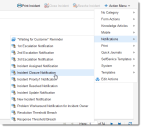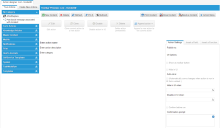Using Quick Actions
•Viewing a List of Quick Actions for a Business Object
•About the Quick Actions Center
•Working with Quick Action Fields
•Adding Multiple Actions to a Quick Action
•Adding a Quick Action Button to the Workspace Toolbar
•Translating the Self Service Quick Action Templates
•Examples of Using Quick Actions
About Quick Actions
A quick action is a user-defined operation that enables you to perform a series of actions or advanced functions with a single click. For example, a quick action can copy an account file or send a confirmation notification upon receipt of an email. Quick actions are handy for often-used activities.
Quick actions are accessed by users logged into a specific role while in a specific workspace.
A quick action can be run against the currently active record or against records in a list.
For example, a quick action can be run against an employee record that is open in the Service Management workspace. A quick action can be run against an active group of records. An example is a saved search that returns employees whose last names begin with the letter H.
Quick actions are accessed from the toolbar on any workspace in Service Manager if a quick action has been published to the workspace and to your role.
You can run quick actions on records directly from the list by selecting the record and applying any of the available quick actions.
Running a Quick Action
1.Log into the Service Manager Application.
2.Open a workspace.
3.Select records. You can also run a quick action from within an open record.
4.From the Action Menu, select a quick action.
Quick Action Menu
The quick action runs.
Viewing a List of Quick Actions for a Business Object
The administrator defines which roles can create, edit, or delete quick actions. See Assigning System Permissions.
To open the Quick Actions Center and view a list of all of the quick actions for a business object, do the following:
1.From the Configuration Console, click Build > Business Objects to open the Business Objects workspace.
2.Open a business object. The application displays the workspace for that business object.
3.Along the top, click Quick Actions. The application opens the Quick Actions Center and lists all of the quick actions associated with that business object.
You can also view the quick actions for a business object by doing the following:
1.From the Configuration Console, click Build > Automation Tools > Quick Actions to open the Actions Manager workspace. The application displays a list of business objects that have quick actions.
2.Click Add/Edit for the business object. The application displays the Quick Actions Center and lists the quick actions for that business object under the Your Actions tab.
About the Quick Actions Center
The Quick Actions Center allows you to create and edit quick actions associated with the workspace or object context.
•Accessing the Quick Actions Center from the Service Manager Application
•Accessing the Quick Actions Center from the Configuration Console
•Parts of the Quick Actions Center
Accessing the Quick Actions Center from the Service Manager Application
To access the Quick Actions Center from the Service Manager Application, your role must have create and edit permission for quick actions. See Assigning System Permissions.
1.Log into the Service Manager Application.
2.Open a workspace.
3.From the Action Menu, select Edit Actions. The Quick Actions Center appears.
Quick Actions Center
Accessing the Quick Actions Center from the Configuration Console
1.From the Configuration Console, click Build > Automation Tools > Quick Actions to open the Actions Manager workspace. The list of business objects that have quick actions appears.
2.Click Add/Edit for the business object for which to see quick actions. The Quick Actions Center appears.
3.Open a quick action from either the Your Actions or the Create New Actions tab.
Parts of the Quick Actions Center
The Quick Actions Center consists of three main areas:
•The quick actions tabs on the left.
| Your Actions | Quick actions defined for the specific workspace and your logged-in role. Some of the quick actions are grouped into folders. By default, the quick actions are filtered based on their association. |
| Create New Actions | Quick action types that you use to create quick actions. |
•The toolbar preview list contains quick actions defined for the workspace.
These actions are defined for each individual workspace by the administrator.
If these actions are not accessible to you, a lock button appears in the upper right corner of each quick action button.
•The quick actions interface is the main area of the window.
| Field | Description |
|---|---|
| Button area | Contains the interface buttons, such as Edit, Clone, Disable, Delete, and Append action. |
| Configuration interface |
Contains the quick action parameters. Each quick action type has different parameters. |
| Action Settings tab | For the selected quick action, contains the publishing permissions, visibility, and prompt requirements. See Action Settings Tab. |
| Insert a Field tab |
Contains the fields and relationships that are associated with a business object. Drag and drop a field or relationship into the configuration interface area. |
| Insert a Function tab | Contains the functions that are associated with a business object. Drag and drop a function into the configuration interface area. |
Creating a Quick Action
1.From the Configuration Console, click Build > Automation Tools > Quick Actions to open the Actions Manager workspace. The list of business objects that have quick actions appears.
2.Click Add/Edit for the business object for which to see quick actions. The Quick Actions Center appears.
3.Select the Create New Actions tab to view a list of quick action guides. These guides are the basis for various quick actions.
4.Select a quick action guide type. The Quick Actions Center appears.
5.Enter data into the configuration fields as needed. Each guide uses different fields. See Common Quick Action Fields.
6.Click Save. The quick action now appears under the No Category section of the Action Menu.
Modifying a Quick Action
You can change specific actions within a quick action. For example, you can change which fields are referenced within a quick action.
1.From the Configuration Console, click Build > Automation Tools > Quick Actions to open the Actions Manager workspace. The list of business objects that have quick actions appears.
2.Click Add/Edit for the business object for which to see quick actions. The Quick Actions Center appears.
3.Select the quick action from the Your Actions list. The Quick Action Configuration interface appears.
4.Click Edit from the button area to activate the configuration interface.
Quick Actions Center Edit
5.Modify the configuration fields as needed.
6.Click Save.
Disabling a Quick Action
You can disable a quick action without deleting it or removing it permanently from the Your Actions list. For example, if you have created a quick action that you might not want to make available immediately, you can disable it.
1.From the Configuration Console, click Build > Automation Tools > Quick Actions to open the Actions Manager workspace. The list of business objects that have quick actions appears.
2.Click Add/Edit for the business object for which to see quick actions. The Quick Actions Center appears.
3.Click the Your Actions tab and select the quick action to disable.
4.From the quick action header, click Disable. The button now reads enable.
5. To enable the quick action, click Enable. The button now reads disable.
Please note that disabled quick actions continue to send notifications when defined operate within a workflow. To prevent disabled quick actions from sending notifications, you must remove the quick action from each workflow block.
Deleting a Quick Action
Except for administrators and roles with delete permissions, you can only delete a quick action that you have created.
•From the Configuration Console
•From the Service Manager Application
From the Configuration Console
1.From the Configuration Console, click Build > Automation Tools > Quick Actions to open the Actions Manager workspace. The list of business objects that have quick actions appears.
2.Click Add/Edit for the business object for which to see quick actions. The Quick Actions Center appears.
3.Click the Your Actions tab and select the quick action to delete.
4.Click Delete. The Delete Confirmation window appears.
Two Delete buttons appear at the top of the Quick Action interface. Choose the lower Delete button to permanently remove the quick action from the application. The upper Delete button is locked.
5.Click Yes.
From the Service Manager Application
1.Log into the Service Manager Application.
2.Open a workspace.
3.From the Action Menu, select Edit Actions. The Quick Actions Center appears.
4.Click the Your Actions tab and select the quick action to delete.
5.Click Delete. The Delete Confirmation window appears.
Two Delete buttons appear at the top of the Quick Action interface. Choose the lower Delete button to permanently remove the quick action from the application. The upper Delete button is locked.
6.Click Yes.


